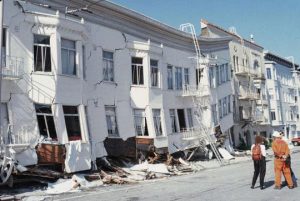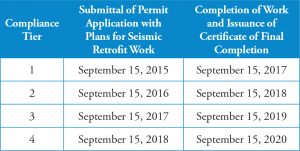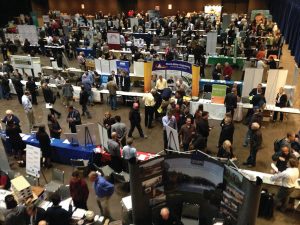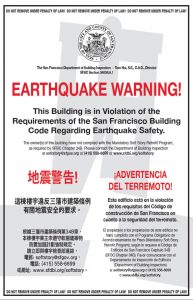In 2013, the City of San Francisco embarked on an ambitious and groundbreaking endeavor: the mandatory seismic retrofit of its wood-framed soft-story apartment buildings. The 1989 Loma Prieta earthquake caused considerable damage to such buildings in the Marina District (Figure 1) and exposed the vulnerability of buildings with soft and weak first stories. Yes, even wood-framed buildings, thought by most engineers to be the most naturally earthquake resistant type of structure due to their lightweight nature and reserve strength, can collapse under the right (or perhaps wrong) circumstances. According to a 2016 report by the Association of Bay Area Governments, San Francisco had 6,700 soft-story buildings, far more than the rest of the region combined.
San Francisco, despite its downtown of steel and concrete high-rises, is really the land of wood structures – long, narrow, multi-story buildings with zero side setbacks. There is almost universally nose-to-tail parking on the ground level and most of the oldest buildings, built before the automobile era, have been modified to allow for parking too. Linear parking configurations make transverse shear walls impossible, and the result was thousands of weak and soft-story buildings.
The intent of this article is not so much to describe the San Francisco Ordinance but to provide insights for other communities that intend to implement mandatory seismic programs. This article is based on the authors’ experiences at a San Francisco firm that has retrofitted over 80 such buildings.
The San Francisco Soft-Story Ordinance
The Mandatory Seismic Retrofit Program (Ordinance No. 66-13) was established by the City of San Francisco in April 2013. The Ordinance addresses wood-framed buildings three-stories or taller, or two-story buildings over a basement or crawl space, with five or more dwelling units, constructed under a permit dated before January 1, 1978, and with no seismic strengthening.
The San Francisco Department of Building Inspection (SFDBI) published Administrative Bulletins 106 and 107, outlining the technical requirements of the retrofit ordinance. Buildings were grouped into four Tiers, with the largest and most vulnerable in Tier 1 (special, institutional, and educational), then Tier 2 (15 or more units), then Tier 3 (5 to 14 units), and then Tier 4 (buildings with ground floor commercial spaces) (Table 1).
The Ordinance requires retrofit work in the weak/soft or “target” story only. The target story is considered weak/soft if the number of walls and the wall layout are significantly different from the typical stories above. San Francisco’s residential buildings commonly have identical or nearly identical plan layouts in the upper stories with a large number of interior walls around small rooms, and open ground levels consisting of undeveloped crawl spaces or developed ground levels with large unobstructed areas used for parking or storage. The lateral force resisting system in the target story must be wood framed elements to be subject to the Ordinance.
Community Outreach and Owner Education
The City undertook a rigorous community outreach campaign. The campaign began by informing owners of buildings that were believed to be part of the program and continued with a number of additional notices and media outreach. The SFDBI website also provided a good description of the program, with links to all important documents.
The City’s Office of Resilience and Recovery team worked with stakeholders to develop and host several financing workshops, annual Earthquake Retrofit fairs attended by over 3,000 people, and a postcard-noticing program (Figure 2). Working directly with SFDBI, the Office of Resilience and Recovery also hosted several public information meetings, giving the public a chance to speak directly with SFDBI staff, experts in disability access and structural engineering, and Rent Board staff (most of the buildings are rent controlled) directly about their questions and concerns. These outreach efforts were intended to educate building owners from a “zero” starting point regarding the Ordinance and to put them in contact with engineers and contractors who were focusing on these projects.
Based on recent data from SFDBI (Table 2), compliance has been excellent for the Tier 2 buildings, the construction for Tier 3 buildings should be complete by September 2019, and Tier 4 is just underway.
Compliance was also aided by an “Earthquake Warning” placard (Figure 3) affixed near the building entrance that alerted tenants and owners alike to the fact their building was out of compliance.
The outreach programs could be improved for future ordinances by more effectively focusing on specific educational needs: selecting the right engineer, selecting the right contractor, financing, and dealing with commercial tenants.
Project Costs
Retrofit costs were initially estimated to be $10,000 to $20,000 per unit. This cost was approximate given the varying sizes of individual units, overall building configurations, and the levelness of the site (San Francisco is very hilly). Due to many factors, including the strength of the regional economy, those costs are very low today. Straightforward projects cost $20,000 to $25,000 per unit, more complicated ones more. In hindsight, it would have been better to estimate the cost of construction on a square foot basis, with annual updates that include current market costs, and let the individual owners calculate their own cost per unit.
The Right Engineer
Skilled building owners and their professional representatives have trouble enough evaluating engineering proposals, but the average apartment building owner is not equipped, even after outreach, to make a reasonable decision. In the beginning, the “early bird” owners selected from a handful of engineers based on interviews and qualifications. Fees were adequate to do proper engineering and the results were good. Over time, more engineers entered the market as the number of buildings requiring retrofit grew. The impact of outreach seemed to fade and inexperienced owners started to select engineers based almost exclusively on design fee. Design fees fell as a result of the competition, making it harder to do a proper job. Owners could not tell what they were getting.
The Right Contractor
Most of the contractors were small residential contractors and new firms formed specifically to serve the soft-story retrofit market. Work quality varied widely; unfortunately, many contractors do not understand enough about seismic retrofit issues. Costs can vary widely and detailed bid break-out was not always provided, even when requested. Building owners got sticker shock if the original cost figures were cemented into their thinking and therefore selected their contractor based on cost without a basis to do otherwise. Owners needed educational outreach to review contractor competence along with guidance from their engineer.
Financing and Cost Recovery
The City offers public financing through Alliance NRG/ Counterpointe Sustainable Real Estate. If used, the NRG financing approach permits the entire cost of the retrofits (100%) and the cost of the financing to be passed on to tenants as approved by the City’s Rent Board (for rent controlled properties). If the owner chooses to self-finance or get a loan from a bank, there are more restrictions on what costs can be passed on to the tenants. Even when the interest rates were lower on a bank loan, the NRG program might have been the better option, but many owners did not grasp this, focusing on the interest rates alone. Some owners were also squeezed by the inability to pass on rent increases to renters who claimed economic hardship. A takeaway is that legislators need to understand the ability of building owners to make the projects work financially and show them how to do it.
Commercial Tenants
The Tier 4 buildings are properties with commercial tenants. These tenants cannot survive in business during the disruption created by extended construction projects. A significant amount of planning and negotiation is necessary to create a workable retrofit approach that addresses temporary relocation and phasing and maintains tenants. Many building owners are not prepared for these tasks, but the projects cannot proceed until these issues are addressed. The Ordinance also triggered ADA upgrades. Finding qualified ADA specialists who are willing to work on small projects has proven to be difficult, although SFDBI has developed a list of such firms.
Technical Provisions
There are three analysis and design methodologies that can be used: California Existing Building Code (2016 CEBC Appendix 4), FEMA P-807, and ASCE 41-13.
- CEBC Appendix 4 – Chapter A4, Earthquake Risk Reduction in Wood-Frame Residential Buildings with Soft, Weak or Open Front Walls, was written to address the soft-story retrofit program. The design is based on 75% of design base shear for a new building. One caveat is that any existing strength contributions from plaster and gypsum board walls within the target story are to be ignored.
- FEMA P-807 – FEMA P-807, Seismic Evaluation and Retrofit of Multi-Unit Wood Frame Buildings with Weak First Stories, is a performance-based approach for the seismic evaluation and retrofit of wood-framed “soft-story” buildings. The downside to this method is that the software requires some degree of experience (by both engineer and plan checker), and judgment is needed in deciding on the final retrofit scheme.
- ASCE 41-13 – This is a great tool, but it is not often used because of its greater complexity compared to the other two methods and engineering fee constraints.
Over time, it became evident that the technical requirements were not as clear as hoped, which led to a problem with the consistency in the application of the program’s technical provisions. The SFDBI looked to the Existing Building Committee of the Structural Engineers Association of Northern California (SEAONC EBC) for guidance, which improved the situation but did not eliminate inconsistencies.
- Strength of the Story Above – The “strength of the story above” is calculated by determining the lengths of interior and exterior walls above the target story and multiplying by their shear strength. Most buildings have interior wood lath and plaster finishes and exterior wood siding, sometimes with stucco. Strengths are listed in California Historical Building Code. In most cases, the total shear strength added up to much more than the 75% design base shear. As a result, the design base shear was insufficient to eliminate the soft- or weak-story condition.
- Multiple R-Values – The retrofits usually involve multiple systems with different R-values. Plywood shear walls are almost always used (R=6.5) but, due to the parking issues, ordinary steel moment frames (R=3.5) and cantilevered column systems (R=2.5) are common. After much debate, R values could be considered on a line by line basis for an A4 analysis, largely because of the assumption of flexible diaphragms. This is allowed by P-807 and ASCE 41.
- Cantilever Column Systems – To maintain parking clearance, engineers designed inverted one-story moment frames with tube columns and concrete grade beams. The SFDBI considered these frames as cantilever column systems, which have a low R-value because the CEBC envisions tall columns standing up through multiple stories. After debate, the SEAONC EBC and SFDBI Structural Subcommittee recommended the R-value correspond to the R-value for an equivalent moment frame system when the columns carry no gravity load and are connected by a concrete grade beam designed to yield the column in flexure. So, even after clarification, it was still up to the engineer to designate the R.
- Foundations – Continuous footings below the wood bearing walls are commonly unreinforced concrete. Some are brick. Although there was no consensus, standard practice was not to replace or strengthen the foundations unless there was a large overturning moment that the existing foundations could not resist. Providing new foundations to resist overturning moments or to address ACI anchor bolt provisions would increase construction costs astronomically.
Plan Review Process
SFDBI data shows that approximately 3,700 building permits of all kinds were issued in 2016 for projects with individual estimated construction costs exceeding $100,000. To date, approximately 3,300 soft-story permits have been issued from 2015 to 2017, or about 1,100 per year. Assuming the 2016 data is a reasonable estimate of annual permit activity, the soft-story program has increased the workload on plan reviewers by 30% per year. That is a significant increase, and the SFDBI staff should be commended for their efforts.
SFDBI reviews projects by formal submittal and also by using an over-the-counter procedure with review time limited to only one hour. If one hour is not enough, formal submittal is required. Most owners and engineers try the over-the-counter process first. However, this puts the plan reviewer in a difficult position because there is considerable pressure to approve the projects in one hour. Inevitably, some inadequate designs may slip through the cracks despite the reviewer’s best efforts.
Having greater plan review staffing during the life of the Ordinance, an increase in the time allotted for over-the-counter reviews, and creating special checking procedures for soft-story projects would be beneficial options to consider. Over-the-counter reviews are likely to become more problematical when the Tier IV buildings are submitted because they are structurally more challenging and involve ADA issues.
Lessons Learned
- There can never be enough education focused on key issues and decisions that building owners will need to make. The audience is diverse and largely uninformed on technical and financial topics. The task is difficult and, when the end result does not cover the needs of all stakeholders, the effectiveness of the program may suffer. Only studies of building performance after the next large earthquake will show the overall result.
- The Ordinance writers attempted to consider as many issues and factors as possible but, understandably, overlooked some things. Moreover, there will always be differences in interpretation. An entity implementing an ordinance needs to have a dedicated advisory panel to educate engineers, engage questions, stimulate discussion, and refine technical requirements to achieve a result consistent with the ordinance goals.
- A mandated ordinance affecting a large number of buildings will put a burden on the plan review organization. Increased staffing and training are required (internal or external), with procedures tailored to the unique aspects of the program.▪





